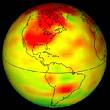Corn Snake
Cornsnake, Red Ratsnake, Red Rat Snake Scientific Name: Elaphe guttata guttata
Mon, 14th July, 2025 - 9:36 pm GMT
Sponsor Ads:

Alternative Name
Cornsnake, Red Ratsnake, Red Rat Snake Scientific Name: Elaphe guttata guttataBasic Info
Corn Snake hatchlings are about 9 to 14 inches long. Adults may be anywhere between 24 and 72 inches, though most sexually mature Corn Snakes are at least 30 inches long, and most do not grow larger than 60 inches. Males will often grow longer than females. The Corn Snake's three primary pigments are yellow, red, and black. The wild-type Corn Snake's dorsal ground color is typically reddish, yellowish, or a shade of gray or tan. Darker large blotches, which are usually a red or orange color and outlined in black, run from the neck all the way down the back, and smaller blotches are often present on the sides. The blotch on the neck branches off into two long stripe-like blotches that run along the top of the head, meeting in a point between the eyes. This marking resembles a spearhead. The scales are very weakly keeled, and the Corn Snake has a divided anal plate. Ventrally the Corn Snake is whitish with staggered black rectangular or square shaped markings that give the underside a characteristic checkerboard appearance. This is a highly variable species that differs somewhat throughout its large range; and there are characteristics typical of certain locality types, giving rise to recognized phases of Corn Snake. The Okeetee Corn Snake has a bright orange ground color and reddish blotches. It was named after a plantation in South Carolina where this attractive morph was often found, but today the name "Okeetee" is frequently used for any similar looking Corn Snake, regardless of its origins. The Miami Phase Corn Snake is, as the name suggests, a common variety in and around Miami, Florida. This phase has a gray ground color with reddish orange blotches. In addition, selective breeding of Corn Snakes has produced a seemingly endless array color and pattern morphs for hobbyists to choose from.
Health
Juvenile Corn Snakes can be housed in 10-gallon terrariums. A 20-gallon-long (30 inches by 12 inches by 12 inches high) will house even the largest adult. Enclosures with more floor space are recommended when housing multiple snakes together. Snakes should be separated when feeding. Suitable substrates include newspaper, outdoor carpeting, pine or aspen shavings, and soil. If using a loose substrate such as soil or wood shavings, it is best to feed the snake in a separate enclosure so that the substrate is not accidentally ingested. Provide hiding places at the warmer and cooler areas of the enclosure. During the day, the ambient temperature should be between 75 and 80 degrees Fahrenheit and they should have a warmer area between 85 and 90 degrees Fahrenheit. At night the temperature can drop to the low to mid 70s Fahrenheit. Hatchlings' enclosures should not drop below 75 degrees Fahrenheit. Breeding Though Corn Snakes may breed without undergoing a winter cooling period, seasonal cycling helps to ensure reproductive success. Only healthy snakes with good body weight should be bromated. The snakes should not be fed for the two weeks prior to cooling them or while they are brumating. The brumation temperature should be between 55 and 70 degrees Fahrenheit. The Corn Snakes will, however, be more active at the high end of this range and so will lose more weight than if they will if kept at the lower temperatures. The temperature should be lowered gradually over a period of about 10 days to the desired temperature, which should be maintained for between 30 and 60 days. The enclosure temperature should then be raised gradually to normal maintenance temperatures. Food should be offered about a week later. Put the pair together immediately following the female's first post-brumation shed, and leave them together for about 5 days. If copulation is not observed, separate them for about a week and try again. Provide a nest box with moist peat moss, vermiculite, or perlite for the female to lay her eggs in. Females usually lay approximately one or two months after coming out of brumation. Most will shed about 10 days prior to laying. The number of eggs per clutch varies from 4 to 40 with the average clutch consisting of between 8 and 16 eggs. Corn Snakes may double-clutch about two months after laying their first clutch. The second clutch in a season usually contains fewer eggs than the first. Incubate the eggs in moist vermiculite or perlite at 80 to 85 degrees Fahrenheit. At these temperatures, eggs will usually hatch in 45 to 55 days. The baby Corn Snakes will shed one to two weeks after hatching and should then be offered newborn pinkie mice. Some Corn Snake hatchlings are reluctant to feed on pinkies and will require small lizards, tube feeding, or use of techniques like lizard scenting or braining the pinkies.Habitat
Corn Snakes are relatively common inhabitants of wooded areas, rocky hillsides, and agricultural fields in the Southeastern United States.Behavior
Corn Snakes were among the first snakes to be kept and bred in captivity; and because they proved to be hardy, docile, easily maintained and easy to breed in captivity, they became very popular. In addition to its more practical attributes, the Corn Snake's popularity was fueled by the fact that it was much less drab than the average colubrid. The Corn Snake has remained a mainstay of the reptile trade, in part, because breeders have produced a wide array of interesting and attractive color morphs to satisfy the hobbyists' need for the new and unusual. The Corn Snake is sometimes referred to as the "Red Rat Snake" because of their reddish coloring and because they are members of the genus Elaphe - the "Rat Snakes". There is some debate over the origin of the name "Corn Snake". The most common explanation is that it comes from the species' tendency to inhabit areas in and around cornfields and places where corn is stored. Others believe that it is derived from the checkerboard pattern on the snake's underside, which resembles a cob of Indian corn.Though they are terrestrial snakes, they are excellent climbers and have been known to make their way up trees to raid bird nests or in search of other prey. Hatchlings primarily prey upon small lizards. Corn Snakes are mostly nocturnal, spending the day resting beneath logs, rocks, and leaf litter. Corn Snakes live in temperate climates and must brumate during the colder months of the year. In the spring, they emerge from their dormancy and breed. Eggs are usually laid in early summer in decaying plant matter or other such areas where they are hidden and moisture can be maintained while the eggs develop. Incubation time varies from between 45 to 90 days.Origin
United StatesHistory
The Corn Snake has a large range that extends from southern New Jersey and Maryland down through Florida and Louisiana, and there are some isolated populations in Kentucky. This species, Elaphe guttata guttata, shares portions of its range with two Corn Snake subspecies - the Emoryis, or Great Plains, Rat snake (E. g. emoryi) in Southern Arkansas to the Gulf and the Rosy Rat snake (E. g. rosacea) in the upper Florida Keyes.Common Foods
Corn Snakes feed on lizards, amphibians, birds, and small mammals in the wild.Sponsor Ads:
If you think that no one cares that you're alive, try missing a few car payments. -- Unknown
Corn Snake
Coded by: BGID® | ALL RIGHTS RESERVED Copyright © 2000-2025
Disclaimer | Privacy | Report Errors / Contact | Credits








 President of the United States of America - Real Estate mogul, Pageant owner and now one of the most controversial men in political history.
President of the United States of America - Real Estate mogul, Pageant owner and now one of the most controversial men in political history.  Global warming has been in and out as the "latest" hot topic for many years. It is, according to modern scientists, the result of man-made industrial pollutants, clearing forested areas, agriculture, etc. But now they are thinking it started way before the Industrial Revolution...
Global warming has been in and out as the "latest" hot topic for many years. It is, according to modern scientists, the result of man-made industrial pollutants, clearing forested areas, agriculture, etc. But now they are thinking it started way before the Industrial Revolution...  Politician, US Vice President and President of the USA - Joseph Robinette Biden Jr.
Politician, US Vice President and President of the USA - Joseph Robinette Biden Jr.  versus
versus  Russia: 'The Evil Empire'? Are they all that bad or is it just the USA trying to portray Russia as bad because they are a world power with land bigger and a society very different from the USA ideal?
Russia: 'The Evil Empire'? Are they all that bad or is it just the USA trying to portray Russia as bad because they are a world power with land bigger and a society very different from the USA ideal? 
 Corona virus
Corona virus 
 Users with wide screen monitors can benefit from more content on every page.
Users with wide screen monitors can benefit from more content on every page.